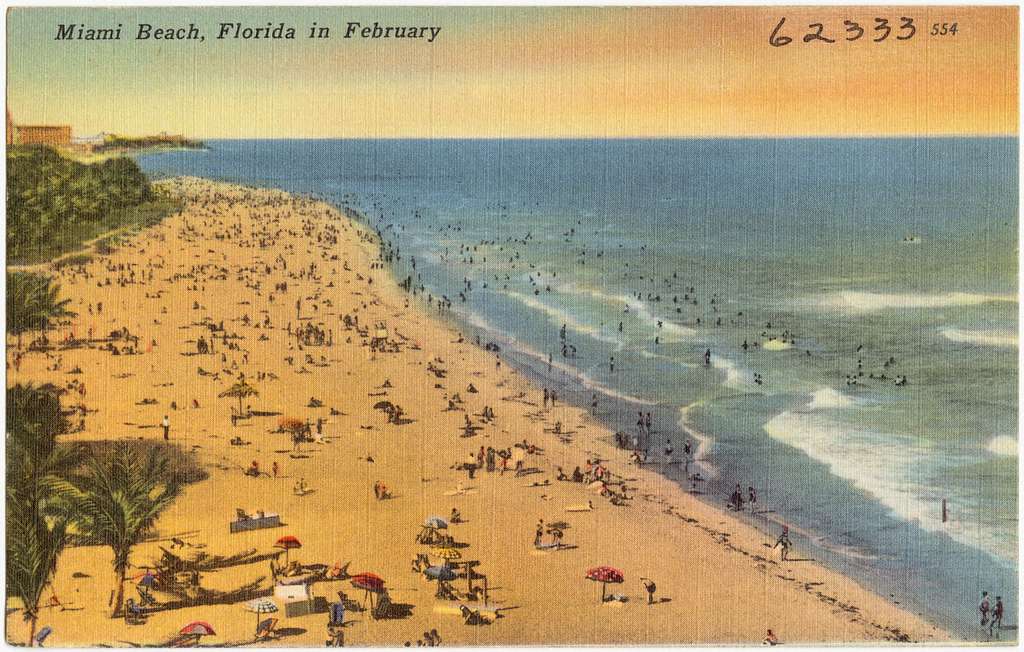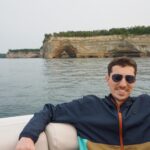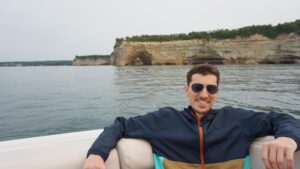Upon moving back to my once-beloved, home state of Florida in the beginning of 2024, I began to experience a disorientation. This seems counterintuitive; after all, I was coming home. But Florida is increasingly become a no-place, a space in which it is very difficult for humans to make a home.
In many ways, South Florida is the perfect microcosm of modern civilization. Among the lines of palm trees and manicured lawns, those who know a bit of its history and ecology can discern the artificial, imposed product that has been constructed on top of a wild and fascinating place. Parts of native Florida remain, but the expansive and encroaching concrete jungle and desolate stroads that carry most Floridians to and fro threaten to blot out these remnants of the authentic Florida.
What is Authentic Florida?
We have to consider the primary nature, character, and attributes of a place in order to make any judgment of how it ought to be today. What was Florida like before real estate speculators began remaking it?
Florida was once a truly wild, raw, and sublimely beautiful—albeit uninhabitable—place. It was a region dominated by subtropical rainforests with an immense, slow-flowing “River of Grass” in its interior, which fed and nourished with pure, nutrient-poor water, all surrounding coastal areas. The seasonal overflowing of Lake Okeechobee through the region we now call the Everglades created a watery habitat which has been seldom seen or duplicated elsewhere in the world. Nearing the coasts, vast forests with pine trees and sand-pine scrub predominated, which provided ample habitat for mammals like raccoons, opossums, deer, and—in Southwest Florida—the much-maligned Florida Panther.
At the coasts, the delicate balance of an immense interior wetland coupled with salty, sun-drenched coastal areas, carved out vast and elaborate coastal rivers and brackish estuaries that were once teeming with life. Many modern readers will be familiar with Florida’s “Intracoastal Waterway,” which was an “improvement” upon nature, whereby existing barrier islands were repurposed and connected as deemed necessary to form an inland, latitudinal vein for commerce and transit. Inlets were then dredged in pre-determined areas to allow ocean access. These historical disruptions in hydrology remain poorly understood or comprehended, but their effects are felt all over South Florida today.
Nonetheless, in the pre-industrial homeostatic environment, vast expanses of coral proliferated off the eastern coast of South Florida (from Stuart to the Dry Tortugas, which lie about 70 miles west of Key West), creating Florida Reef, which has now been reduced to about 1% of its pre-industrial stony coral cover. Over eons—and with changing climates that caused sea levels to ebb and flow—the Florida Keys, which are the only subtropical coralline islands in the contiguous United States, were formed. The islands which today constitute the terrestrial Florida Keys were once underwater coral mountains, where the living colonial organisms known as coral polyps once thrived and built immense reef structures, in a bank-barrier arrangement. Today, one will find the remnants of the modern reef structure eroding at an alarming rate; in the vacuum afforded by the vanquished reef-builders, soft, weedy, and opportunistic corals and sponges have proliferated—but each year, the Florida Reef inches closer and closer to geologic death, meaning the reef system is eroding faster than new coral can accrete via recruitment and calcium carbonate deposition. This demise was comparatively glacial until 1983, when the Diadema Antillarum sea urchin—which consumes benthic algae and detritus for sustenance—suffered a Caribbean-wide mass mortality event due to a still unidentified pathogen. Since 1983, coral—particularly the fast-growing Acropora species, Acropora Cervicornis and Acropora Palmata—has died in the Florida Keys National Marine Sanctuary at a breakneck pace.
When did “Civilization” Come to Florida?
Most people don’t realize just how recently “civilization” in an industrialized sense was brought to Florida. While Europe was marching off to war in the summer of 1914, Florida was still a vast, largely untamed wilderness. In Western popular culture, the United States’ “Wild West” is often considered the last truly free and wild frontier, but historically, Florida was the contiguous United States’ last frontier, which was not fully settled or adorned with modern conveniences like intricately connected (st)roadways, air conditioning, or culture—the latter of which would eventually take the form of amusement and entertainment—until the latter half of the twentieth century. In general terms, it wouldn’t be inaccurate to say that the two innovations of land reclamation and air conditioning are what made Florida habitable.
One hundred years ago, Florida was a raw, sublimely beautiful but uninhabitable wilderness, one that had many more (non-native) disease-carrying Aedes Aegypti mosquitoes, alligators, snakes, sharks, and other natural pestilences than people. Around the turn of the twentieth century, this began to change via the advent of Henry Flagler’s “Florida East Coast Railway,” which would eventually connect Jacksonville to Key West, with notable stops along the way at St. Augustine, West Palm Beach, Ft. Lauderdale, and Miami. But this process of creating logistical transportation arteries via railroad-ification—which dammed and severed Florida’s natural watersheds—did not transform Florida over a fortnight. In fact, when Flagler’s railroad did reach Key West in January of 1912—a mere four months before the sinking of White Star’s infamous RMS Titanic—his conquest of the sea was relatively short-lived: for in 1935 one of the most powerful hurricanes in recorded history pummeled the Florida Keys, destroying large spans of the “Railroad that Went to Sea.” And so, for a brief period in the subsequent depression and war-ridden years, it seemed as though Flagler’s conquest of nature was all for naught. But it is hard to know whether it is nature or man that is more stubborn and persistent: in the post-WWII years, the defunct and destroyed remnants of Flagler’s “Overseas Railroad” were reclaimed, restored, and repurposed, forming the basis of what is now known as the “Overseas Highway,” bringing with it civilization—and its discontents.
It’s foolish to pin the blame for what has happened to Florida on one renowned and celebrated man, but it should be noted that it was his idea to civilize the seemingly un-civilizable as a northerner’s escape for the wealthy during winter, and this idea ultimately led to the creation of what Florida is today—for better and worse. I therefore think it reasonable to assert that Henry Flagler is one of the “Founding Fathers” of artificial Florida, along with Napoleon Bonaparte Broward, Julia Tuttle, and a few others.
Napoleon Bonaparte Broward and his Disciples
A contemporary of Flagler was Florida’s nineteenth (and perhaps most infamous) governor, Napoleon Bonaparte Broward, for whom “Broward County” in South Florida is aptly named. Broward campaigned upon the promise to “drain the swamp” and once taking office, he began to do just that. His idea was—and it should be noted that he was in no way alone in what has, with hindsight, become “exhibit A” for modern civilized man’s vanity, pride, and folly—to drain the ecological treasure, now known as the Everglades, in order to repurpose it as a mere natural resource for agricultural and civilizational purposes. The problem, as we have come to find out, was that this process was done hastily and in a non-deliberative manner, for at this time Florida was still the edge of the world and as a result, this popular land-reclamation movement was able to proceed recklessly and unabated, without proper oversight or planning.
Further extensions of the principles of Broward were the damming of Lake Okeechobee and dredging of two functionally equivalent but distinctive waterways, which were designed to drain surplus water from Lake Okeechobee during the wet season. These rivers were created by connecting the newly dredged inland and artificial waterways to two previously existing, coastal rivers: the St. Lucie in the East and Caloosahatchee in the West, respectively. The result of this process was the nearly complete disconnection of the Everglades watershed that historically originated at the Kissimmee River—which was also straightened to allow for more efficient agricultural usage with ill effects—from the Everglades proper. As such, South Florida has been plagued with a manmade water management crisis for over 50 years where Florida Bay has become a warm, hyper-saline environment which has increasingly resulted in mass die-offs of expansive subaqueous seagrass meadows, which then, in turn, float to the surface and decay in the intense sunlight, providing ample fodder to fuel massive algae blooms and red tides. This is to say little of the nutrient pollution of the Everglades ecosystem—as well as the coastal rivers and estuaries—which have all but been destroyed by the introduction of massive quantities of nutrient and heavy-metal laden freshwater and sediment into what were historically nutrient-poor brackish and salt water coastal regions.
What is Artificial Florida?
Without becoming bogged down in the muck, the preceding context provides context for the following postulate: Florida, as it exists today, is an almost entirely artificial creation. Don’t get me wrong: there are still remnants of the old, essential Florida in abundance—particularly in various state and national parks, as well as along the coasts. If one so chooses, he or she may find and live (almost entirely) in “Old Florida,” while reaping the rich benefits and conveniences of modern life. It is not for these people (often not native to Florida) to whom I am writing, but rather those who occupy and defend—whether overtly or implicitly—the artificial, unreal Florida.
Before proceeding further, I must issue the following disclaimer to state definitively and clearly that I’m not arguing against the progress that is civilization, when properly applied, which I take to mean: the sensible improvement of nature so as to preserve its essential order while creating a more habitable context within which humans can live well. Many cultures, both in the West and elsewhere, managed to do this before a colonial, industrial, short-sighted materialism came to cultural dominance.
As evidence of the previous claim, one may consider the creation of the many gardens in Europe during the early-Modern and Modern periods—whether English or French in conception. Despite differences in style, gardens represent man seeking to cooperate with nature in order to improve her, aiming at the ideals of beauty and harmonious order. It is in the vast gardens of Europe, particularly those competing gardens of Blenheim and Versailles respectively, where nature has been put on display in such a way to demonstrate the beauty of creation, as well as man’s stubborn persistence and ingenuity to carve out an improved and cultivated environment to inhabit. Taking the raw material of nature and envisioning improvement constitutes a supreme act of creation, which is not either an imitation nor replacement of nature, but rather a stewarding of nature that makes the world more beautiful and habitable so that civilization and its higher offspring like art, literature, and philosophy may flourish.
By seeking to replace nature with an imposed human vision, Florida’s “Robber Barons” transformed it into a northerner’s paradise. Today’s Florida is then working as intended, since it was designed for escapism, the pursuit of temporary and transient pleasures, amusements, and entertainment: the latter of which is forever enshrined in the public’s unconscious consciousness by way of Florida’s litany of theme parks. I’m not suggesting that human culture should be dour, pretentious, or in any way “un-fun,” but amusement in the absence of substance is cancerous and a surefire way to eventual meaninglessness and nihilism. At Florida’s inception, other possibilities for exploration and adventure were present, which were (and still are to some extent) provided by eco-tourism and the like. But it seems that as time has progressed (and South Florida has become further developed and gentrified), these more primal pursuits have been increasingly sanitized and made sterile—and are perhaps on the way to being retired altogether.
And this progression from the raw, unabated natural Florida to the ever-more artificial Florida, has grave consequences for both the geographical locale and the people who inhabit it. Some of these maladies are obvious: incessant traffic and construction, environmental pollution and degradation, an exorbitant cost of living, a general lack of freedom and increased legality and taxation, as well as a palpable increase in general social dysfunction and hostility; other effects are much more difficult to detect and discern and so remain more insidious.
Can Community Take Root in Artificial Florida?
Florida as an intensified microcosm of patterns that are unfolding all over the United States and other western countries presses upon us fundamental questions: What does the Florida-fication of the world do to human culture and community? Can people make common cause and find a common home in an environment so manufactured and imposed on the natural world? Florida’s rapid one-hundred year transformation—from raw, rugged, and expansive wilderness, into a largely artificial concrete jungle aimed at fulfilling the perpetual human appetites for quick, easy, and transient pleasures—is an experiment that offers some answers to these questions.
Living in a degraded and deracinated place such as South Florida has an effect on its inhabitants that is seldom consciously conceived or analyzed. After all, a common colloquial trope in the immensely beautiful but morally decadent Florida Keys is “come on vacation, leave on probation.” This statement is generally said tongue-in-cheek, but humor often has the ring of truth. This is why in Florida, “Florida Man” abounds. This is not to say that there are not a multitude of wonderful individuals and families who occupy South Florida (I am proud to know and call many of these friends and loved-ones), and there are even pockets of coherent community that have taken hold along the margins of this manufactured environment. I simply want to acknowledge that living in a place where there is an overbearing and oppressive societal pressure that directs humans away from higher and more permanent things and towards those which are more shallow and ultimately fleeting, has a marked effect on people. To what extent this effect is irresistible I cannot say, for the human spirit is incredibly resilient. I fear, however, that in an increasingly concrete and plastic world—cut off from our collective Source of which nature is most emblematic and readily apparent—the effect of such corruptions will continue to increase in intensity and frequency. This is why the Florida of 2024, intuitively from my vantage point, seems to have further degraded from 2014 (or 2004) Florida.
Upon moving back to Florida in 2024 after a four-year hiatus, I have been immediately flummoxed by the general lack of community, sense of common good and purpose, and overarching hostility that governs how Floridians interact with one another. But perhaps this is to be expected in such an over-developed, artificial, and heterogeneous place that is but an extreme version of a society lacking much common purpose, one in which tolerance seems to be the highest ethical principle? It seems to me that without a uniting ethos, convictive purpose, or general principles held in common—without even a given place that the community shares—there is nothing to stitch individuals into a coherent culture. Hence social fragmentation appears, to me at least, to be the defining characteristic of contemporary Artificial Florida.
My return here has come with a silver lining: experiencing Florida once more has given me a renewed appreciation and thirst for community, belonging, and place in a metaphysically significant sense. Sadly, it seems I will have to leave Florida to find such a place.
Image via Collections – GetArchive






3 comments
Art Kusserow
Drew, thank you for this essay.
Since 2014 (or 2004) is a drop in the bucket, I was hoping to hear more elaboration on some specifics of how you experienced the change you allude to in that microscopic slice of time. My curiosity is primed. Perhaps a theme for another essay?
Buzzard
Originally from Boynton Beach myself, now up in Brevard. Watching South Florida and the defense industry terraform the area. The Coasts, I believe, are a lost cause. Better for us to go inland. Yeehaw Junction is still holding it down. Archer, Zolfo Springs, Clewiston, etc. Look for cattle and/or sugar cane. Work to defend the land and preserve the culture.
Just like happened after the First and Second Seminole wars we are being pushed into marginal areas. Accept it, find a spot you like, and begin strengthening it against the day the developers come.
I hold out hope that it’ll take one good hurricane to spook alot of folks off the peninsula. That and any major event that knocks out the power during the summer for about two weeks. Ask any hiker or rancher and they’ll tell you the climate is getting MORE extreme. Few and far between are the transplants that can survive without AC. The entire edifice is built on shaky ground.
Stay close to the land. Love it, nurture it, pray for it. Keep these lines in your heart:
– Wisdom 16:24
– Job 5:22-24
– Jeremiah 29:4-7
Recommended reading:
Oklahoma Seminoles : Medicines, Magic, and Religion by James H. Howard. How did the Seminoles adapt to a dry, alien desert and keep their culture alive? Read and learn, start getting to work.
See you at the Battle of Okeechobee reenactment. I’ll have a green cowboy hat.
Brian
“it seems I will have to leave Florida to find such a place.”
If you’re “from” Florida, then I’d suggest that Florida is by far your best chance to find what you’re looking for. Pretty much everywhere you go that’s seen growth in the past few decades you’re going to find little but stroads, subdivisions, and strip malls, but even if you somehow find a community of “your” people somewhere else, who happen to be in a similar phase of life, etc., the likelihood that it will last, and not dissipate over time, is very, very small.
Comments are closed.